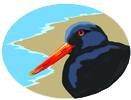
In 1782 the Bald Eagle was chosen as our national symbol for its strength, fierce demeanor, and loyalty. Others, including Ben Franklin, mumbled that they are pirates who steal fish from Ospreys and are scavengers that feed on carrion. They also spend a lot of time hanging out at dumps. Still, I think all are awed by the sight of this majestic bird.
Bald Eagles are recognized by their giant size. They can stand three feet tall and have a wingspan of six feet. It takes four years for them to get that pure white head and tail of an adult. Adults have a large, yellow beak and yellow lower legs that are not feathered. Their fiercelooking eye is also yellow.
In winter, they are a rare and exciting visitor to the coast. In summer, Some nest around northern California’s lakes and large rivers but most head farther north. Pairs are extremely loyal and most mate for life. Still, each spring courtship is dramatic, including flight displays when pairs lock talons and plummet to earth in a series of whirling summersaults.
They are known for making the largest single nest, which can be over fifteen feet across. One nest has been used for thirty-five years. Both male and female incubate the two white eggs for three weeks. One chick will hatch first. In most years the second chick will not survive because of starvation or harassment by the larger one. This is termed obligate siblicide. Our national symbol is also a symbol of hope. Bald Eagles were extremely threatened, due to pesticides and to being shot by ranchers. In 1963, there were 417 nests in all the United States. Now, because of protection, there are over 10,000 nesting pairs. In 2007, they were removed from the endangered species list.
Bald Eagle photo Ron LeValley www.levalleyphoto.com
